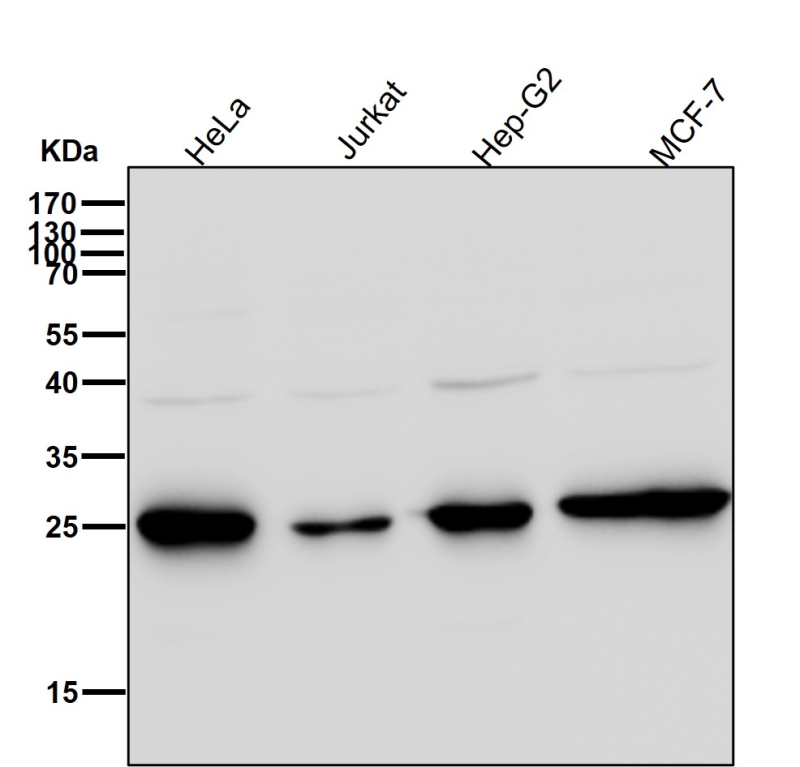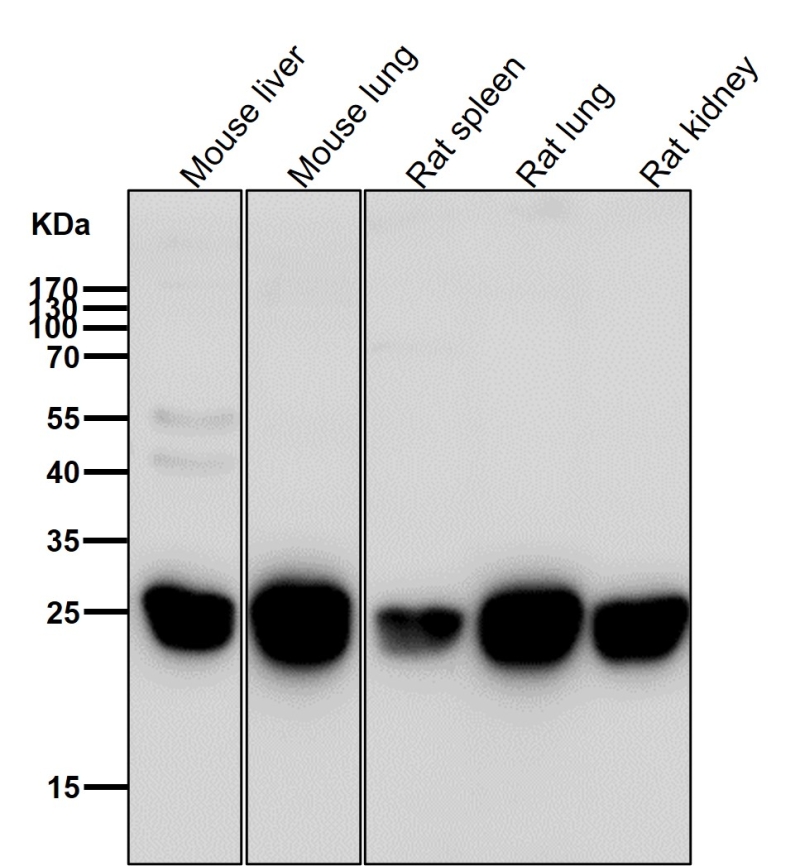


| WB | 咨询技术 | Human,Mouse,Rat |
| IF | 1/20-1/50 | Human,Mouse,Rat |
| IHC | 咨询技术 | Human,Mouse,Rat |
| ICC | 1/50-1/200 | Human,Mouse,Rat |
| FCM | 咨询技术 | Human,Mouse,Rat |
| Elisa | 咨询技术 | Human,Mouse,Rat |
| Aliases | Peroxiredoxin-6; Antioxidant protein 2; Liver 2D page spot 40; NSGPx; PRDX6; AOP2; KIAA;;PRDX6 |
| WB Predicted band size | 25 kDa |
| Host/Isotype | Rabbit IgG |
| Antibody Type | Primary antibody |
| Storage | Store at 4°C short term. Aliquot and store at -20°C long term. Avoid freeze/thaw cycles. |
| Species Reactivity | Human,Mouse,Rat |
| Immunogen | A synthesized peptide derived from human PRDX6 |
| Formulation | Purified antibody in PBS with 0.05% sodium azide,0.05% BSA and 50% glycerol. |
+ +
以下是关于PRDX6抗体的3篇代表性文献及其摘要概括:
1. **文献名称**: *"Peroxiredoxin 6 in pulmonary oxidative stress: molecular mechanisms and therapeutic opportunities"*
**作者**: Fisher AB et al.
**摘要**: 该研究利用PRDX6特异性抗体验证其在肺组织中的抗氧化功能,发现PRDX6通过调节磷脂酶A2活性减轻氧化应激诱导的肺损伤,抗体检测显示其表达水平与肺部疾病严重程度相关。
2. **文献名称**: *"PRDX6 as a novel biomarker for hepatocellular carcinoma: validation by immunohistochemistry"*
**作者**: Kim HS et al.
**摘要**: 通过免疫组化(使用兔源PRDX6单克隆抗体)分析肝癌组织样本,发现PRDX6在肝癌细胞中显著高表达,且其表达水平与患者预后不良相关,提示其可作为肝癌诊断标志物。
3. **文献名称**: *"Antibody-based detection of PRDX6 isoforms in neurodegenerative disorders"*
**作者**: Singh S et al.
**摘要**: 研究开发了针对PRDX6不同磷酸化修饰位点的特异性抗体,发现阿尔茨海默病患者脑组织中PRDX6的异常磷酸化与其抗氧化功能受损相关,抗体特异性验证为疾病机制研究提供了工具。
4. **文献名称**: *"Targeting PRDX6 sensitizes cancer cells to ferroptosis via antibody-mediated functional blockade"*
**作者**: Wang Y et al.
**摘要**: 利用抗PRDX6中和抗体抑制其磷脂修复活性,证明阻断PRDX6可增强癌细胞对铁死亡的敏感性,为基于抗体疗法的癌症治疗策略提供了实验依据。
这些文献涵盖了PRDX6抗体在疾病机制、诊断标志物开发及治疗应用中的关键作用。
Peroxiredoxin 6 (PRDX6) is a unique member of the peroxiredoxin family, a group of antioxidant enzymes critical for regulating oxidative stress and maintaining cellular redox homeostasis. Unlike other peroxiredoxins, PRDX6 possesses dual enzymatic activities: glutathione peroxidase activity, which neutralizes hydrogen peroxide and lipid peroxides, and calcium-independent phospholipase A2 (iPLA2) activity, involved in membrane repair and lipid metabolism. This multifunctional protein is ubiquitously expressed in tissues, with high levels in the lungs, liver, and brain, playing roles in cell protection, signal transduction, and inflammatory responses.
PRDX6 antibodies are essential tools for studying its expression, localization, and function in both physiological and pathological contexts. These antibodies enable detection via techniques like Western blotting, immunohistochemistry, and immunofluorescence, aiding research into diseases linked to oxidative damage, such as cancer, neurodegenerative disorders, and acute lung injury. PRDX6's involvement in pathways like NF-κB and MAPK signaling further underscores its relevance in inflammation and apoptosis.
Structurally, PRDX6 lacks the typical N-terminal peroxiredoxin domain, featuring a single conserved cysteine residue (1-Cys) instead of the 2-Cys mechanism seen in other family members. Antibodies targeting specific epitopes help distinguish PRDX6 from homologs, ensuring specificity in studies. Recent research highlights its dual roles as a protector against oxidative stress and a potential contributor to disease progression in certain cancers, making PRDX6 antibodies vital for exploring therapeutic strategies targeting redox regulation.
×